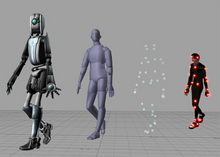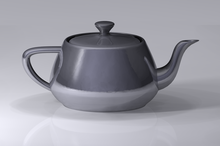3D modeling: Difference between revisions
m rv linkspam |
→Representation: New image |
||
| Line 18: | Line 18: | ||
=== Representation === |
=== Representation === |
||
[[Image:Utah teapot.png|thumb| |
[[Image:Utah teapot simple 2.png|thumb|A modern render of the iconic [[Utah teapot]] model developed by [[Martin Newell]] (1975). The Utah teapot is one of the most common models used in 3D graphics education.]] |
||
Almost all 3D models can be divided into two categories. |
Almost all 3D models can be divided into two categories. |
||
* '''Solid''' - These models define the volume of the object they represent (like a rock). These are more realistic, but more difficult to build. Solid models are mostly used for nonvisual simulations such as medical and engineering simulations, and for specialized visual applications such as [[ray tracing]] and [[constructive solid geometry]] |
* '''Solid''' - These models define the volume of the object they represent (like a rock). These are more realistic, but more difficult to build. Solid models are mostly used for nonvisual simulations such as medical and engineering simulations, and for specialized visual applications such as [[ray tracing]] and [[constructive solid geometry]] |
||
Revision as of 06:39, 2 July 2008
It has been suggested that Virtual model be merged into this article. (Discuss) Proposed since February 2008. |
| Three-dimensional (3D) computer graphics |
|---|
 |
| Fundamentals |
| Primary uses |
| Related topics |
In 3D computer graphics, 3D modeling is the process of developing a mathematical, wireframe representation of any three-dimensional object (either inanimate or living) via specialized software. The product is called a 3D model. It can be displayed as a two-dimensional image through a process called 3D rendering or used in a computer simulation of physical phenomena. The model can also be physically created using 3D Printing devices.
Models may be created automatically or manually. The manual modeling process of preparing geometric data for 3D computer graphics is similar to plastic arts such as sculpting.
Models
3D models represent a 3D object using a collection of points in 3D space, connected by various geometric entities such as triangles, lines, curved surfaces, etc. Being a collection of data (points and other information), 3D models can be created by hand, algorithmically (procedural modeling), or scanned.
3D models are widely used anywhere 3D graphics are used. Actually, their use predates the widespread use of 3D graphics on personal computers. Many computer games used pre-rendered images of 3D models as sprites before computers could render them in real-time.
Today, 3D models are used in a wide variety of fields. The medical industry uses detailed models of organs. The movie industry uses them as characters and objects for animated and real-life motion pictures. The video game industry uses them as assets for computer and video games. The science sector uses them as highly detailed models of chemical compounds. The architecture industry uses them to demonstrate proposed buildings and landscapes. The engineering community uses them as designs of new devices, vehicles and structures as well as a host of other uses. In recent decades the earth science community has started to construct 3D geological models as a standard practice.
Representation

Almost all 3D models can be divided into two categories.
- Solid - These models define the volume of the object they represent (like a rock). These are more realistic, but more difficult to build. Solid models are mostly used for nonvisual simulations such as medical and engineering simulations, and for specialized visual applications such as ray tracing and constructive solid geometry
- Shell - these models represent the surface, not the volume (like an eggshell). These are easier to work with than solid models. Almost all visual models used in games and film are shell models.
Because the appearance of an object depends largely on the exterior of the object, boundary representations are common in computer graphics. Two dimensional surfaces are a good analogy for the objects used in graphics, though quite often these objects are non-manifold. Since surfaces are not finite, a discrete digital approximation is required: polygonal meshes (and to a lesser extent subdivision surfaces) are by far the most common representation, although point-based representations have been gaining some popularity in recent years. Level sets are a useful representation for deforming surfaces which undergo many topological changes such as fluids.
The process of transforming representations of objects, such as the middle point coordinate of a sphere and a point on its circumference into a polygon representation of a sphere, is called tessellation. This step is used in polygon-based rendering, where objects are broken down from abstract representations ("primitives") such as spheres, cones etc, to so-called meshes, which are nets of interconnected triangles. Meshes of triangles (instead of e.g. squares) are popular as they have proven to be easy to render using scanline rendering. Polygon representations are not used in all rendering techniques, and in these cases the tessellation step is not included in the transition from abstract representation to rendered scene.
Modeling processes
There are three popular ways to represent a model:
- Polygonal modeling - Points in 3D space, called vertices, are connected in a linear fashion to form a polygonal mesh. Used for example by 3DS Max. The vast majority of 3D models today are built as textured polygonal models, because they are the most flexible and quickest for the computer to handle. However, polygons cannot be bent. Curved surfaces are approximated by using many small flat surfaces.
- NURBS modeling - NURBS Surfaces are defined by Spline curves, which are influenced by weighted control points. The curve follows (but does not necessarily interpolate) the points. Increasing the weight for a point will pull the curve closer to that point. NURBS are truly smooth surfaces, not approximations using small flat surfaces, and so are particularly suitable for organic modelling. Maya is the most well-known commercial software that uses NURBS natively.
- Splines&Patches modeling - Like NURBS, Splines and Patches depend on curved lines to define the visible surface. Patches fall somewhere between NURBS and polygons in terms of flexibility and ease of use.
The modeling stage consists of shaping individual objects that are later used in the scene. There are a number of modeling techniques, including:
Modeling can be performed by means of a dedicated program (e.g., Maya, 3DS Max, Blender, Lightwave, Modo) or an application component (Shaper, Lofter in 3DS Max) or some scene description language (as in POV-Ray). In some cases, there is no strict distinction between these phases; in such cases modelling is just part of the scene creation process (this is the case, for example, with Caligari trueSpace and Realsoft 3D).
Complex materials such as blowing sand, clouds, and liquid sprays are modeled with particle systems, and are a mass of 3D coordinates which have either points, polygons, texture splats, or sprites assign to them.
Scene setup
Scene setup involves arranging virtual objects, lights, cameras and other entities on a scene which will later be used to produce a still image or an animation.
Lighting is an important aspect of scene setup. As is the case in real-world scene arrangement, lighting is a significant contributing factor to the resulting aesthetic and visual quality of the finished work. As such, it can be a difficult art to master. Lighting effects can contribute greatly to the mood and emotional response effected by a scene, a fact which is well-known to photographers and theatrical lighting technicians.
It is usually desirable to add color to a model's surface in a user controlled way prior to rendering. Most 3D modeling software allows the user to color the model's vertices, and that color is then interpolated across the model's surface during rendering. This is often how models are colored by the modeling software while the model is being created. The most common method of adding color information to a 3D model is by applying a 2D texture image to the model's surface through a process called texture mapping. Texture images are no different than any other digital image, but during the texture mapping process, special pieces of information (called texture coordinates or UV coordinates) are added to the model that indicate which parts of the texture image map to which parts of the 3D model's surface. Textures allow 3D models to look significantly more detailed and realistic than they would otherwise.
Other effects, beyond texturing and lighting, can be done to 3D models to add to their realism. For example, the surface normals can be tweaked to affect how they are lit, certain surfaces can have bump mapping applied and any other number of 3D rendering tricks can be applied.
3D models are often animated for some uses. They can sometimes be animated from within the 3D modeler that created them or else exported to another program. If used for animation, this phase usually makes use of a technique called "keyframing", which facilitates creation of complicated movement in the scene. With the aid of keyframing, one needs only to choose where an object stops or changes its direction of movement, rotation, or scale, between which states in every frame are interpolated. These moments of change are known as keyframes. Often extra data is added to the model to make it easier to animate. For example, some 3D models of humans and animals have entire bone systems so they will look realistic when they move and can be manipulated via joints and bones, in a process known as skeletal animation.
Compared to 2D methods
3D Photorealistic effects are often achieved without wireframe modeling and are sometimes indistinguishable in the final form. Some graphic art software includes filters that can be applied to 2D vector graphics or 2D raster graphics on transparent layers.
Advantages of wireframe 3D modeling over exclusively 2D methods include:
- Flexibility, ability to change angles or animate images with quicker rendering of the changes;
- Ease of rendering, automatic calculation and rendering photorealistic effects rather than mentally visualizing or estimating;
- Accurate photorealism, less chance of human error in misplacing, overdoing, or forgetting to include a visual effect.
Disadvantages compare to 2D photorealistic rendering may include a software learning curve and difficulty achieving certain hyperrealistic effects. Some hyperrealistic effects may be achieved with special rendering filters included in the 3D modeling software. For the best of both worlds, some artists use a combination of 3D modeling followed by editing the 2D computer-rendered images from the 3D model.
3D model market
There is a large and thriving market for 3D models (as well as 3D-related content, such as textures, scripts, etc.), either as individual models or large collections. Online marketplaces for 3D content allow individual artists to sell content that they have created. Often, the artists' goal is to get additional value out of assets they have previously created for projects. By doing so, artists can earn more money out of their old content, and companies can save money by buying pre-made models instead of paying an employee to create one from scratch. These marketplaces typically split the sale between themselves and the artist that created the asset, often in a roughly 50-50 split. In most cases, the artist retains ownership of the 3d model; the customer only buys the right to use and present the model.
Collections of hundreds to thousands of 3D models on CD, often royalty free, are for sale. These models include different types of people, animals, objects, plants, rocks, tools, furniture, buildings, landscapes, historical objects, cartoon characters, monsters, science fiction objects, medieval fantasy objects, etc. A person who buys such a CD can import these posable ready-made models into their computer animation program.
See also
- Computer facial animation
- Cloth modeling
- Digital geometry
- Geological modelling
- Image development
- SIGGRAPH
- Stanford Bunny
- Utah Teapot
- Voxel
